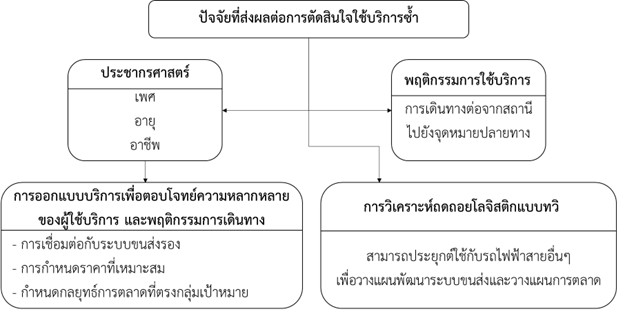Factors affecting customers' decision for repeated usage of The Pink Line mass transit system (Khae Rai - Min Buri)
Main Article Content
Abstract
This study aimed to investigate (1) demographic factors; (2) behavioral factors; and (3) marketing mix factors on the decision for repeated usage of The Pink Line mass transit system (Khae Rai - Min Buri). The Pink Line mass transit system (Khae Rai - Min Buri), which connects key areas in Bangkok and Nonthaburi, plays a significant role in shaping travel behavior. Understanding the factors affecting repeat usage is essential for planning and developing transportation systems that align with users’ long-term needs. Data were collected from a sample of 400 samples through questionnaires in Bangkok and Nonthaburi. The data were analyzed using descriptive statistics, inferential statistics, and binary logistic regression analysis. The results indicated that the factors that significantly affected the decisions to repeat the service were 1) demographic factors which were gender, age, occupation, and income; 2) behavioral factors which were the choice of transportation mode after disembarking from the Pink Line to reach the final destination; and 3) marketing mix factors (7Ps) which were product (travel speed, convenience, and system reliability), price (appropriateness of fare relative to travel distance), place (adequacy of ticket booth facilities), promotion (suitability of EMV Contactless card’s promotional pricing and associated partner stores), process (support systems for people with disabilities), and physical evidence (availability of shops and services in the stations). The findings of this study can be utilized to inform the planning, development, and refinement of service models and marketing strategies for The Pink Line mass transit system (Khae Rai - Min Buri). These improvements aim to better meet the needs of passengers and support the growing urban expansion, ultimately contributing to an increase in ridership.
Article Details

This work is licensed under a Creative Commons Attribution-NonCommercial-NoDerivatives 4.0 International License.
References
การรถไฟฟ้าขนส่งมวลชนแห่งประเทศไทย. (2566ก). รายงานประจำปี 2566. สืบค้นจาก https://www.mrta.co.th/th/annual-report/18186.
การรถไฟฟ้าขนส่งมวลชนแห่งประเทศไทย. (2566ข). รายงานฉบับสมบูรณ์ผลการสำรวจ ครั้งที่ 1 (Final Report) ประจำปี 2566. สืบค้นจาก https://www.mrta.co.th/th/satisfaction-survey-reports/14804.
กิรณา สินเจริญ. (2550). ปัจจัยทีมีผลต่ออุปสงค์ของผู้ใช้บริการรถไฟฟ้ามหานคร สายเฉลิมรัชมงคล. (เศรษฐศาสตรมหาบัณฑิต, มหาวิทยาลัยศรีนครินทรวิโรฒ).
ปองพล นิกรกิตติโกศล. (2557). ปัจจัยที่มีอิทธิพลต่อความพึงพอใจในการใช้บริการรถไฟฟ้าบีทีเอสของผู้ใช้บริการในเขตกรุงเทพมหานคร. (บริหารธุรกิจมหาบัณฑิต, มหาวิทยาลัยธรรมศาสตร์).
ยุวดี วรสิทธิ์ และ เอก ชุณหชัชราชัย. (2559). ปัจจัยด้านคุณภาพบริการ และพฤติกรรมการใช้บริการรถไฟฟ้าแอร์พอร์ตเรลลิ้งก์ที่มีผลต่อทัศนคติของผู้ใช้บริการในกรุงเทพมหานคร. วารสารบริหารธุรกิจเทคโนโลยีมหานคร, 13(1), 24-42.
วริศรา เจริญศรี. (2560). ปัจจัยที่มีอิทธิพลต่อการตัดสินใจใช้รถไฟฟ้าบีทีเอส. (เศรษฐศาสตรมหาบัณฑิต, มหาวิทยาลัยธรรมศาสตร์).
โสภิตา รัตนสมโชค. (2558). ปัจจัยส่วนประสมทางการตลาด (7Ps) ที่มีอิทธิพลต่อความพึงพอใจในการใช้บริการรถไฟฟ้าเฉลิมพระเกียรติ (บีทีเอส) ของประชากรในเขตกรุงเทพมหานคร. (บริหารธุรกิจมหาบัณฑิต, มหาวิทยาลัยธรรมศาสตร์).
Kotler, P., & Keller, K. L. (2016). Marketing management. (15th global ed.). Edinburgh: Pearson Education.
Nunnally, J. C. (1978). Psychometric theory. (2nd ed.). New York: McGraw-Hill.
Payne, A. (1993). The essence of service marketing. London: Prentice Hall.
Rasca, S., & Saeed, N. (2022). Exploring the factors influencing the use of public transport by commuters living in networks of small cities and towns. Travel Behaviour and Society, 28, 249–263.
Yamane, T. (1973). Statistics: An introductory analysis. (2nd ed.). New York: Harper & Row.

